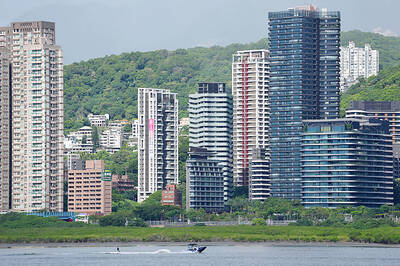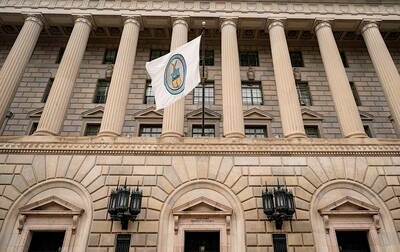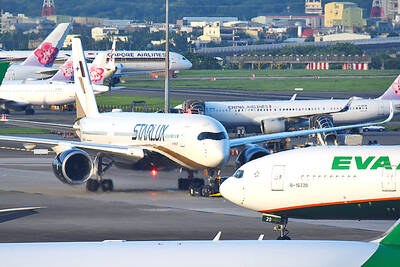Taipei has the lowest office fit-out costs in the Asia-Pacific region, averaging US$70 per square foot (0.09m2), a survey released yesterday by international property broker Cushman & Wakefield showed.
“With average costs of US$70 per square foot, Taipei is the most economical city for office fit-out in [the] Asia-Pacific,” Cushman & Wakefield said, citing its latest office fit-out cost guide, which aims to assist corporate occupiers in drawing up capital planning and relocation budgets.
Office fit-out costs average about US$110 per square foot in the region, although the range is wide, from as little as US$45 per square foot in Taipei to as much as US$275 per square foot in Tokyo, it said.
Construction costs continue to rise, especially in Japan, where preparation for next year’s Tokyo Olympics has exerted greater pressure on available resources, Cushman & Wakefield said, explaining why Tokyo has the highest office fit-out costs, averaging US$202 per square foot.
Robust economic growth across the region this year has driven corporate expansion, which has led to healthy demand for office space, it said.
With limited space available in many cities, competition for space has intensified, fueling rental growth, it added.
Moving forward, corporate occupiers will scrutinize costs closely, with the cost of office fit-outs being a high-priority concern for relocation projects, it said.
A workplace environment that is functional, tech-enabled and flexible, with a variety of work settings and amenities, are the benchmark considerations today.
“The tech-savvy generation expects a high level of technology adoption in the workplace, which enables them to access information easily and quickly in a comfortable environment,” Cushman & Wakefield said.
Large augmented virtuality set-ups, real-time data on display with the latest tech amenities at fast speeds mean higher costs related to high performance and cooling facilities to maintain comfort levels, it said.
Sustainability factors, such as the type of materials used in the fit-out, would also directly affect costs, it said.
“In Taipei, turnkey solution is the most popular approach clients are looking at,” said Gary Chan (詹畢仁), head of project and development services in Taiwan.
Clients prefer to partner with professional project managers with design and build experience to support their upcoming projects, Chan said.

Taiwan’s rapidly aging population is fueling a sharp increase in homes occupied solely by elderly people, a trend that is reshaping the nation’s housing market and social fabric, real-estate brokers said yesterday. About 850,000 residences were occupied by elderly people in the first quarter, including 655,000 that housed only one resident, the Ministry of the Interior said. The figures have nearly doubled from a decade earlier, Great Home Realty Co (大家房屋) said, as people aged 65 and older now make up 20.8 percent of the population. “The so-called silver tsunami represents more than just a demographic shift — it could fundamentally redefine the

The US government on Wednesday sanctioned more than two dozen companies in China, Turkey and the United Arab Emirates, including offshoots of a US chip firm, accusing the businesses of providing illicit support to Iran’s military or proxies. The US Department of Commerce included two subsidiaries of US-based chip distributor Arrow Electronics Inc (艾睿電子) on its so-called entity list published on the federal register for facilitating purchases by Iran’s proxies of US tech. Arrow spokesman John Hourigan said that the subsidiaries have been operating in full compliance with US export control regulations and his company is discussing with the US Bureau of

Businesses across the global semiconductor supply chain are bracing themselves for disruptions from an escalating trade war, after China imposed curbs on rare earth mineral exports and the US responded with additional tariffs and restrictions on software sales to the Asian nation. China’s restrictions, the most targeted move yet to limit supplies of rare earth materials, represent the first major attempt by Beijing to exercise long-arm jurisdiction over foreign companies to target the semiconductor industry, threatening to stall the chips powering the artificial intelligence (AI) boom. They prompted US President Donald Trump on Friday to announce that he would impose an additional

China Airlines Ltd (CAL, 中華航空) said it expects peak season effects in the fourth quarter to continue to boost demand for passenger flights and cargo services, after reporting its second-highest-ever September sales on Monday. The carrier said it posted NT$15.88 billion (US$517 million) in consolidated sales last month, trailing only September last year’s NT$16.01 billion. Last month, CAL generated NT$8.77 billion from its passenger flights and NT$5.37 billion from cargo services, it said. In the first nine months of this year, the carrier posted NT$154.93 billion in cumulative sales, up 2.62 percent from a year earlier, marking the second-highest level for the January-September